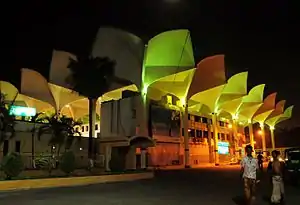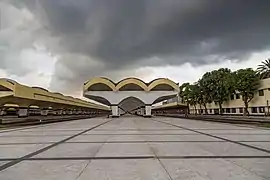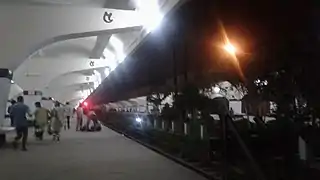Kamalapur railway station
Kamalapur Railway Station (officially known as Dhaka railway station) is the central railway station of Bangladesh. It is situated at the north–east of Motijheel, Dhaka. It is the largest railway station in the country and the most important terminal for transportation between Dhaka and the rest of Bangladesh. The station building is one of the most modern and striking buildings in Dhaka designed by Berger Consulting. The design process started under the direction of Daniel Dunham followed by Robert Boughey.
Kamalapur railway station কমলাপুর রেলওয়ে স্টেশন | |
|---|---|
| B class railway station in Bangladesh | |
 | |
| Other names | Dhaka railway station |
| Location | Motijheel, Dhaka Dhaka Division |
| Coordinates | 23°43′55″N 90°25′34″E |
| Owned by | Bangladesh Railway |
| Operated by | Bangladesh Railway |
| Line(s) | Narayanganj–Bahadurabad Ghat |
| Platforms | 8 |
| Construction | |
| Structure type | Standard (on ground station) |
| Other information | |
| Status | Functioning |
| Station code | DA |
| History | |
| Opened | April 27, 1968 |
Narayanganj–Bahdurabad Ghat line | ||||||||||||||||||||||||||||||||||||||||||||||||||||||||||||||||||||||||||||||||||||||||||||||||||||||||||||||||||||||||||||||||||||||||||||||||||||||||||||||||||||||||||||||||||||||||||||||||||||||||||||||||||||||||||||||||||||||||||||||||||||||||||||||||||||||||||||||||||||||||||||||||||||||||||||||||||||||||||||||||||||||||||||||||||||||||||||||||||||||||||||||||||||||||||||||||||||||||||||||||||||||||||||||||||||||||||||||||||||||||||||||||||||||||||||||||||||||||||||||||||||||||||||||||||||||||||||||||||||||||||||||||||||||||||||||||||||||||||||||||||||||||||||||||||||||||||||||||||||||||||||||||||||||||||||||||||||||||||||||||||||||||||||||||||||||||||||||||||||||||||||||||||||||||||||||||||||||||||||||||||||||||
|---|---|---|---|---|---|---|---|---|---|---|---|---|---|---|---|---|---|---|---|---|---|---|---|---|---|---|---|---|---|---|---|---|---|---|---|---|---|---|---|---|---|---|---|---|---|---|---|---|---|---|---|---|---|---|---|---|---|---|---|---|---|---|---|---|---|---|---|---|---|---|---|---|---|---|---|---|---|---|---|---|---|---|---|---|---|---|---|---|---|---|---|---|---|---|---|---|---|---|---|---|---|---|---|---|---|---|---|---|---|---|---|---|---|---|---|---|---|---|---|---|---|---|---|---|---|---|---|---|---|---|---|---|---|---|---|---|---|---|---|---|---|---|---|---|---|---|---|---|---|---|---|---|---|---|---|---|---|---|---|---|---|---|---|---|---|---|---|---|---|---|---|---|---|---|---|---|---|---|---|---|---|---|---|---|---|---|---|---|---|---|---|---|---|---|---|---|---|---|---|---|---|---|---|---|---|---|---|---|---|---|---|---|---|---|---|---|---|---|---|---|---|---|---|---|---|---|---|---|---|---|---|---|---|---|---|---|---|---|---|---|---|---|---|---|---|---|---|---|---|---|---|---|---|---|---|---|---|---|---|---|---|---|---|---|---|---|---|---|---|---|---|---|---|---|---|---|---|---|---|---|---|---|---|---|---|---|---|---|---|---|---|---|---|---|---|---|---|---|---|---|---|---|---|---|---|---|---|---|---|---|---|---|---|---|---|---|---|---|---|---|---|---|---|---|---|---|---|---|---|---|---|---|---|---|---|---|---|---|---|---|---|---|---|---|---|---|---|---|---|---|---|---|---|---|---|---|---|---|---|---|---|---|---|---|---|---|---|---|---|---|---|---|---|---|---|---|---|---|---|---|---|---|---|---|---|---|---|---|---|---|---|---|---|---|---|---|---|---|---|---|---|---|---|---|---|---|---|---|---|---|---|---|---|---|---|---|---|---|---|---|---|---|---|---|---|---|---|---|---|---|---|---|---|---|---|---|---|---|---|---|---|---|---|---|---|---|---|---|---|---|---|---|---|---|---|---|---|---|---|---|---|---|---|---|---|---|---|---|---|---|---|---|---|---|---|---|---|---|---|---|---|---|---|---|---|---|---|---|---|---|---|---|---|---|---|---|---|---|---|---|---|---|---|---|---|---|---|---|---|---|---|---|---|---|---|---|---|---|---|---|---|---|---|---|---|---|---|---|---|---|---|---|---|---|---|---|---|---|---|---|---|---|---|---|---|---|---|---|---|---|---|---|---|---|---|---|---|---|---|---|---|---|---|---|---|---|---|---|---|---|---|---|---|---|---|---|---|---|---|---|---|---|---|---|---|---|---|---|---|---|---|---|---|---|---|---|---|---|---|---|---|---|---|---|---|---|---|---|---|---|---|---|---|---|---|---|---|---|---|---|---|---|---|---|---|---|---|---|---|---|---|---|---|---|---|---|---|---|---|---|---|---|---|---|---|---|---|---|---|---|---|---|---|---|---|---|---|---|---|---|---|---|---|---|---|---|---|---|---|---|---|---|---|---|---|---|---|---|---|---|---|---|---|---|---|---|---|---|---|---|---|---|---|---|---|---|---|---|---|---|---|---|---|---|---|---|---|---|---|---|---|---|---|---|---|---|---|---|---|---|---|---|---|---|---|---|---|---|
| ||||||||||||||||||||||||||||||||||||||||||||||||||||||||||||||||||||||||||||||||||||||||||||||||||||||||||||||||||||||||||||||||||||||||||||||||||||||||||||||||||||||||||||||||||||||||||||||||||||||||||||||||||||||||||||||||||||||||||||||||||||||||||||||||||||||||||||||||||||||||||||||||||||||||||||||||||||||||||||||||||||||||||||||||||||||||||||||||||||||||||||||||||||||||||||||||||||||||||||||||||||||||||||||||||||||||||||||||||||||||||||||||||||||||||||||||||||||||||||||||||||||||||||||||||||||||||||||||||||||||||||||||||||||||||||||||||||||||||||||||||||||||||||||||||||||||||||||||||||||||||||||||||||||||||||||||||||||||||||||||||||||||||||||||||||||||||||||||||||||||||||||||||||||||||||||||||||||||||||||||||||||||
| Source: Bangladesh Railway Route Map | ||||||||||||||||||||||||||||||||||||||||||||||||||||||||||||||||||||||||||||||||||||||||||||||||||||||||||||||||||||||||||||||||||||||||||||||||||||||||||||||||||||||||||||||||||||||||||||||||||||||||||||||||||||||||||||||||||||||||||||||||||||||||||||||||||||||||||||||||||||||||||||||||||||||||||||||||||||||||||||||||||||||||||||||||||||||||||||||||||||||||||||||||||||||||||||||||||||||||||||||||||||||||||||||||||||||||||||||||||||||||||||||||||||||||||||||||||||||||||||||||||||||||||||||||||||||||||||||||||||||||||||||||||||||||||||||||||||||||||||||||||||||||||||||||||||||||||||||||||||||||||||||||||||||||||||||||||||||||||||||||||||||||||||||||||||||||||||||||||||||||||||||||||||||||||||||||||||||||||||||||||||||||
History
Fulbaria railway station was the central railway station of the then East Bengal and then, after the partition of Bengal, the East Pakistan. After the partition, Dhaka became an important and densely populated city,[1] and so there were plans to make a newer bigger railway station that would replace the old Fulbaria railway station and would provide a more grand and symbolic gateway to the capital Dhaka. Suggestions by experts for the replacement was made in 1948 and after a decade, in 1958, the provincial government was entrusted with executing the plan. Kamalapur in Motijheel was selected for extension. Prior to the station being constructed, the land was a paddy field. The construction started at the end of 1950s and completed in 1968. A new railway line from Tejgaon to Khilgaon, and then Kamalapur was made. It was inaugurated on 27 April 1968.[1][2] The last train to depart Fulbaria railway station was 7 no. up train with locomotive no. 2000 (the first diesel locomotive of the country), which departed on 30 April 1968 at 11:10 pm. On the next day, Fulbaria railway station was closed completely and taken out.
Architectural value
Berger Consultants from New Jersey had opened a branch office in Dhaka in 1960 and won the contract to design the station. Daniel Dunham headed the local office with an architecture degree from Harvard and Post-graduate degree from School of Tropical Architecture, London. His thesis project at Harvard was large span thin-shell concrete design and he explored many options to span the vast station roof. Since the governor promoted Mogul motif pointed arch for all government projects, it required exploring multiple options and an umbrella-shaped repetitive form that looked like a pointed arch when seen from frontal view was one of the options explored during preliminary stages.
When Robert Boughey took over the helm of the Dhaka office after Daniel Dunham joined the newly formed Architecture Department at EPUET, he went back to the umbrella scheme and won approval to proceed with design and preparation of construction documents. The vaulted domes were cast-in-place concrete with wood-framed formwork that could be reused. The high roof element provided a grand scale, protection from rain, sun and sheltered the two-story office block below to become a fitting gateway to Dhaka. Kamalapur railway station was one of the most important establishments in East Pakistan at that time, and it was also one of the few beautiful structures in Dhaka.
The station contains 21 ticket counters, and local tickers can be bought from 20 ticket counters. Tickets are available to go to India. There are one first-class and one second-class waiting rooms. The station has eight platforms and there are two restaurants in front of the ticket counters and fast food shops near the ticket counters.
Present condition
There are 47 local trains, 40 mail/ express trains and 30 inter-city trains going through the station. The station has many security guards, station masters, along with one station manager. There are trains to Jamalpur, Rajshahi, Khulna, Chittagong, Sylhet, Rangpur, Dinajpur, etc. The station is sometimes used as a sleeping place for homeless people.
Gallery
 Night view
Night view Exterior view
Exterior view Interior view
Interior view Entrance gate
Entrance gate Train record board
Train record board Platform no. 2
Platform no. 2 Platform no. 3
Platform no. 3 Platform no. 5
Platform no. 5 Platform no. 6
Platform no. 6 Platform no. 7
Platform no. 7 Sonar Bangla Express standing
Sonar Bangla Express standing Dhaka railway station central jama masjid
Dhaka railway station central jama masjid
References
- "A quiet masterpiece that serves as Dhaka's gateway". The Daily Star. 2017-07-24. Retrieved 2020-11-05.
- "Banglapedia". Asiatic Society of Bangladesh. Retrieved 2020-06-19.
Further reading
- Rahman, Mahbubur (2012). "Architecture". In Islam, Sirajul; Jamal, Ahmed A. (eds.). Banglapedia: National Encyclopedia of Bangladesh (Second ed.). Asiatic Society of Bangladesh.
- James-Chakraborty, Kathleen (2014). "Reinforced concrete in Louis Kahn's National Assembly, Dhaka: Modernity and modernism in Bangladeshi architecture". Frontiers of Architectural Research. 3: 81–88. doi:10.1016/j.foar.2014.01.003.
Daniel Dunham, Pioneer of Modern Architecture in Bangladesh by Rafique Islam ISBN 978-0-9834694-3-8 pages 83–90 Kamalapur Railway Station